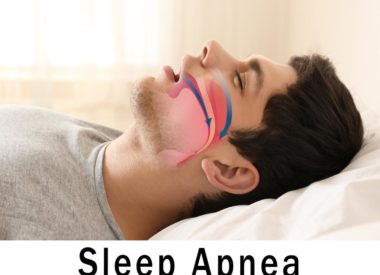Cranial Problems and Sleep Breathing Disorders
Cranial problems can often lead to sleep breathing disorders. Craniofacial anomalies (CFA) are a distinct set of deformities found in facial bone and head growth. Anomaly means ‘different from normal’ or ‘irregularity’. These abnormalities are present at birth (congenital) and vary in intensity with some being mild while others are serious needing surgery.
Most medical experts agree that there are various factors that contribute to the development of an abnormality including:
Gene Combination
You can get a certain combination of genes from either parent or both. Your genes may change at the time you are conceived which leads to a craniofacial anomaly.
Environmental
Its thought that environmental exposures, although not fully understood, could play a role in craniofacial abnormality development, particularly when combined with genetic abnormalities.
Deficiency in Folic Acid
Folic acid is a type of B vitamin that you find in enriched grain products, fortified breakfast cereals, leafy, green vegetables and orange juice. When pregnant women don’t get enough folic acid, it increases the risk of their baby having some type of congenital anomaly, including cleft palate or cleft lip.
Cranial Problems that Can Lead to Sleep Breathing Disorders like Sleep Apnea
Cranial problems can lead to sleep breathing disorders like sleep apnea. Sleep apnea is a condition that occurs while you are sleeping and is where you pause between breaths or have shallow breathing. When you pause between breaths with sleep apnea, the pauses can last anywhere from a couple seconds to a couple minutes before you begin breathing normally again. These pauses are sometimes followed with a choking sound or loud snort. Obstructive sleep apnea is a common type of sleep apnea.
When you do experience sleep apnea, it can significantly fragment your sleep. This leads to a poor quality of sleep. With kids, this condition can cause hostile or angry behavior, hyperactivity, memory and learning deficits and poor school performance.
Some cranial shape issues that can lead to sleep apnea include:
Cleft Issues
There are a number of cleft issues with two of the most common being cleft lip and cleft palate. Cleft lip iswhere your lip doesn’t form completely. How severe your cleft lip can be may vary from being mild where you have notching of your lip to severe where you have a big opening going from your lip up through your nose.
When the roof of your mouth doesn’t close completely and leaves an opening that extends into your nasal cavity, this is known as a cleft palate. This type of cleft can affect either palate side and may extend from the hard palate (front of your mouth) to the soft palate (throat). It can also include your lip.
Kids who have facial clefts often suffer from obstructive sleep apnea as well. It’s important that you inform a cleft surgeon and otolaryngologist if your child is suffering with obstructive sleep apnea or other sleep breathing disorder since these disorders are thought to lead to cognitive difficulties and need to be managed right away.
In many cases, kids who have clefts typically have a positive sleep study. Therefore its imperative that otolaryngologists are aware of the increased risk that children have for sleep disorders when they have cleft deformities as well as potential treatments.
Chiari Malformation
This is a structural defect in the area of your brain that controls your balance known as the cerebellum. Your cerebellum along with parts of your brain stem is located in the lower back of your skull inside an indented space above your foramen magnum. A Chiari malformation is where you have a part of your cerebellum sitting below your foramen magnum.
Chiari malformations occur when you have smaller than normal bony space which causes your brain stem and cerebellum to be pushed into your upper spinal canal, down in your foramen magnum. This can lead to pressure on your brainstem and cerebellum that could impact certain functions that these areas control and block your cerebrospinal fluid flow. This fluid is clear and flows to and from your brain while surrounding and cushioning your spinal cord and brain. Some people with Chiari malformations have been diagnosed with sleep disorders, particularly sleep apnea.
Deviated Nasal Septum
Your nasal septum is the wall that separates your nasal cavity into halves and is made up of a central supporting skeleton with both sides being covered by mucous membrane. The front part is a cartilage structure that bends but is firm and acts like a natural partition. It’s covered by skin with a significant number of blood vessels. When your nasal septum is precisely midline and separates the right and left sides of your nose into equally sized passageways, this is seen as ideal.
When your septum is shifted away from your midline severely, it’s known as a ‘deviated septum’. If you have a deviated septum, chances are you are having trouble breathing through your nose. This can be worse on one side and is in some cases the side that is opposite of the bend. It can often interfere with your sinus drainage which can lead to repeated sinus infections and sleep apnea.
High Arched Soft Palate
When you have a high arched palate, your palate is uncommonly narrow and high. This developmental characteristic can occur with a number of conditions or happen by itself. Chronic thumb-sucking can cause this condition. Having a high arched palate could lead to a narrow airway and a sleep breathing disorder like sleep apnea.
Palate Problems
Your palate is your roof of your mouth and separates your nasal cavity from your oral cavity. It is divided into two parts: the velum (posterior fleshy soft palate) and the anterior bony hard palate. Individuals with sleep apnea are typically overweight and their tongue and soft palate are increased in size.
Even if you don’t have a cranial disorder, sleep apnea can still occur with a misshaped cranium such as in the case of retrognathia. Evidence has shown that retrognathia can disrupt your breathing, particularly when you are sleeping. This often leads to sleep apnea. With retrognathia, your jaw shifts your tongue back into your airway and leads to choking or gasping and pauses in breathing.
With retrognathia, you typically have a recessed mandible (lower jaw). It sometimes affects your maxilla (upper jaw). With this condition, you don’t necessarily have an abnormally small jaw; its just set back when your face is being seen in profile view.
It’s important that you realize that cranial shape issues can lead to sleep breathing problems like sleep apnea. Therefore, if you or a loved one has a type of craniofacial anomaly, it’s a good idea to get a sleep study at a sleep clinic to find out ways to prevent or treat the possibility of a sleep breathing problem. Things like medication, dental appliances, surgery or CPAP therapy may be used. All of these have been shown effective in treating sleep apnea and other sleep breathing disorders.
Sound Sleep Health in Seattle/Kirkland has a free eBook that covers the signs and symptoms of sleep apnea…just click the image below and you’ll be on your way to learning more about this condition!
Sources:
http://www.stanfordchildrens.org/en/topic/default?id=overview-of-craniofacial-anomalies-90-P01830
http://www.ccakids.com/assets/one-sheet_sleep-apnea.pdf
http://www.pcsortho.org/LinkClick.aspx?fileticket=8zpCOGJSHVY%3D&tabid=94
http://www.prnewswire.com/news-releases/does-a-narrow-maxillary-arch-lead-to-breathing-problems-or-vice-versa-300288525.html
http://www.huffingtonpost.co.uk/sarah-ockwellsmith/baby-sleep-training_b_10196792.html
http://www.ucirvinehealth.org/health-library/content/?contentTypeID=90&contentID=P01830
https://www.ncbi.nlm.nih.gov/pubmed/23000731
https://rarediseases.org/rare-diseases/chiari-malformations/
http://www.webmd.com/allergies/deviated-septum#1
https://en.wikipedia.org/wiki/High-arched_palate
http://www.aafp.org/afp/1999/1115/p2279.html
1GuilleminaultC,AbadVC,ChiuH, Peters BR, and Quo S. Missing teeth and pediatric obstructive sleep apnea. Sleep and Breathing. 2015 Sep 2.



